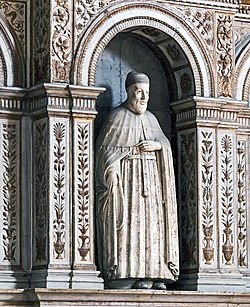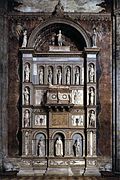History
The first historical information about organs in the Frari basilica dates back to the fifteenth century. In 1483, a chronicle of the convent refers to the existence of a "perfectum" organ. In service for more than thirty years ranging approximately from 1593 at least until 1629. Girolamo Diruta (1586-1589) and Giovanni Picchi are among the most famous organists of the basilica during that period.
An engraving depicting the choir of the basilica made by Father Vincenzo Coronelli in 1708, shows that the basilica then had two organs on the perimeter wall of the choir that were facing one another and placed sideways on the choir stalls.
The left organ was probably built by Giovan Battista Piaggia in 1732, this instrument could therefore be one of his first works. The activity, known up to now, of this Venetian organ builder extends, in fact, from 1740 to 1760, the organ he built for the Venetian church of San Giovanni Evangelista dates back to that date and has remained almost unchanged; the latter therefore served as a term of comparison to validate the attribution of that of the Frari and, above all, to allow its reconstruction in 1970. In fact, after Gaetano Callido had built the front organ (1795), this instrument was progressively abandoned, so as to reach the early seventies almost completely stripped of the metal rods.
The organ on the right was built by Gaetano Callido in 1795 or 1796. Almost uninterrupted documentation from then until the early decades of the twentieth century provides information confirming that, unlike the other organ in the pair, this instrument was entrusted to qualified organ builders for ordinary maintenance and, from time to time, the organ on the right was restored with substantial respect for its authenticity.
Problems regarding restoration of the two ancient organs was faced in 1969. Following construction of new organ with electropneumatic transmission (1928) by Mascioni, an organ located in the apse close to Titian's Assumption, use of the Callido organ decreased so much over time that between 1929 and 1969 there were no maintenance interventions on the original pared organs.
The restoration of the pared organs was unequal. Given the good condition of conservation and integrity of the right organ, an intervention of extraordinary maintenance was all that was needed. While a more radical intervention was needed for the left organ that called for a reconstruction in the strictest sense, since there were seven façade pipes, all the internal mechanics, nine wooden pipes, and a bellows were missing. For this reconstruction all the surviving elements were used and, on the basis of these, also making comparisons with the organ of San Giovanni Evangelista, the measures of the pipes were established.
The restoration made it possible to appreciate again the round and robust sounds of the Callido organ and the transparent and delicate timbre of the Piaggia organ, closer to Renaissance sound models. Eventually, the instruments were tuned in unison, in order to be played together. After more than thirty years, a new revision work was promoted, which was completed in the months of April and May 2004.
Thanks to the availability of two organs placed on two opposing choirs that was typical of a musical style in vogue in Venice in the sixteenth and seventeenth centuries, the practice of the double choir is restored in the basilica of the Frari. It is the last surviving example in Venice - and one of the rare examples in Italy - of two choirs with functioning historical organs.
Mascioni organ
The basilica also housed the Mascioni opus 398 pipe organ, built in 1928. It was placed behind the Assunta altarpiece of the main altar. It was electrically driven, had three keyboards of 61 notes each (C1-C6), and a pedalboard of 30 (C1-F3).
It was the largest organ in Venice, the only one with three manuals from the Cecilian period. It was the only instrument that allowed the performance of concerts with a repertoire that could range from the Romantic to the contemporary period.
Despite the transformation of the transmission from pneumatic to electric, the organ preserved all the pipes (about 2000), the bellows, and the wind chests (with the exception of that of the third manual that was destroyed by high water during the restoration of the Pala Assunta in the 1960s), and the beautiful wooden console table, with its original ivory keys.
In 2018, the organ, fully functional and active in liturgies and concerts, was disassembled to allow the complete restoration of the altarpiece and the frame of the painting of the Assumption, with no idea of where to place it at the end of the restoration of the painting. In 1965 it had already been dismantled to allow the restoration of the altarpiece in a previous intervention, once restored, the organ had been rebuilt in 1977, many parts were destroyed, including the wind chest of the 3rd manual, but many other patios were resumed and reassembled because they were missing, some registers from the same period also made by Mascioni. The patient work was performed by Maestro Alessandro Girotto. The completed organ was inaugurated with a concert by the concert master Sergio De Pieri, then organist of the basilica.
The Mascioni organ now has been donated to the parish church of Santa Maria Ausiliatrice in Lido di Jesolo (Venice) with extensive plans for it to be mounted. Restorations and tampering by the Zanin di Codroipo company that are necessary to adapt the organ for use in a different location, however, will leave the city of Venice without its only romantic-symphonic concert instrument.





































